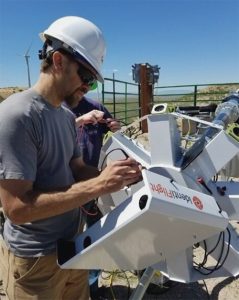IdentiFlight® announced an independent study, “Automated curtailment of wind turbines reduces eagle fatalities,” that was recently published in the Journal of Applied Ecology. Conducted by The Peregrine Fund, in cooperation with Western EcoSystems Technology, Inc. and the US Geological Survey, at a wind farm site in Wyoming, the research showed use of the IdentiFlight system resulted in an 82 percent reduction of eagle fatalities.
“Avian collisions with turbine blades have been a long-time concern in the wind industry. The IdentiFlight avian detection technology was developed to address this problem and promote the successful coexistence of avian wildlife and wind energy,” said Ben Quinn, Senior Vice President at IdentiFlight. “We now have conclusive evidence that IdentiFlight can be utilized as a mitigation and minimization solution for current and future wind projects.”
Dr. Chris McClure, Director of Global Conservation Science at The Peregrine Fund and lead author on this study, noted, “These results show that using the IdentiFlight system can lessen numbers of fatalities of eagles at wind energy facilities, reducing the conflict between wind energy and raptor conservation. As this technology continues to develop and improve, it has the potential to greatly impact raptor conservation around the globe.”

Continually Evolving Technology
The IdentiFlight system is commercially deployed at projects around the world and has actively tracked and documented over 2.2 million eagle tracks. Documented images increase by more than 10 million every year with over 47 million images of protected species gathered. With every image, the IdentiFlight system becomes more accurate and robust.
Carlos Jorquera, Chief Technology Officer for IdentiFlight, stated, “One of the advantages of the IdentiFlight system is its ability to learn from the massive amounts of data that it collects daily from eagles and other protected bird species around the world. By leveraging artificial intelligence technologies, such as machine learning and convolutional neural networks, the system continuously improves as the data set grows.”
Quinn added, “In fact, IdentiFlight has achieved dramatic improvements in the time since this study was completed with expanded capabilities and new avian species added to better serve global needs, including Red and Black Kites, Golden Eagles, Bald Eagles, Wedge-tailed Eagles, White-tailed Eagles, Lesser Spotted Eagles, and Condors. We are excited about the future of IdentiFlight and look forward to continuing to demonstrate that wildlife and wind generation can coexist.”
How IdentiFlight Works
The IdentiFlight system blends artificial intelligence with high-precision optical technology to detect eagles and other protected avian species. Proprietary software and neural network technologies process the images to determine 3D position, velocity, trajectory, and protected species of interest, all within seconds of detection. IdentiFlight towers operate as an autonomous system detecting, classifying, and curtailing specific turbines that could pose a risk to the bird. The system detects a bird as far as one kilometer away, classifying it as a protected species such as an eagle (or not) in real-time. The IdentiFlight towers can be positioned to cover multiple turbines in a single wind farm. When installed as a network with overlapping aerial coverage, the systems work together to provide the most protection possible for avian activity in the area.





